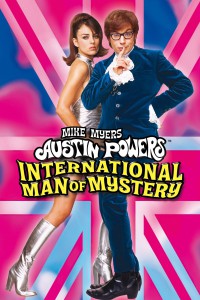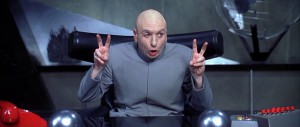From the Chicago Reader (May 1, 1997). — J.R.

After 30 years of cryogenic preservation, the title hero (a spin-off of James Bond and his clones) and his archenemy Dr. Evil — both played by writer and coproducer Mike Myers (Wayne’s World) — emerge in the present to match wits all over again. What’s really fun about this silly but spirited comedy isn’t just the ribbing of swinging London fashion and social attitudes but the use of the compulsive zooms and split-screen mosaics of commercial movies of the 60s (some of the funniest gags derive from camera placement). There’s a bit of fudging when it comes to the romantic interest: sidekick Elizabeth Hurley initially blanches at Austin Powers’s advances but succumbs as soon as he treats her to a night on the town in Las Vegas, complete with champagne and Burt Bacharach. But 60s (and 50s) icons like Robert Wagner and Michael York (playing someone called Basil Exposition) make this exercise in historical relativity even funnier. Jay Roach directed with just the right amount of period tackiness. With Mimi Rogers, Seth Green, and Fabiana Udenio (as Alotta Fagina). (JR)
 Read more
Read more
From Monthly Film Bulletin, September 1976, Vol. 43, No. 512. — J.R.

De Naede Faergen (They Caught the Ferry)
Denmark, 1948
Director: Carl Th. Dreyer
Dist–Guild Sound & Vision. p.c–Ministeriernes Filmudvalg. sc–Carl Th. Dreyer. Derived from a work by Johannes V. Jensen. ph–Jørgen Roos. ed–Carl Th. Dreyer. sd–Jorgen Roos. l.p–(not credited). 408 ft. 11 mins. (16 mm.).

Behind the credits, accompanied by the ominous sound of three beats on a kettledrum, a ferry arrives at the Assens-Aarøsund landing. After some reverse-angle cuts between ferry and landing, a motorcyclist on board asks the captain about the next departure of the ferry on the other side of the island. ToId that it leaves in forty-five minutes but that he’ll never make it — the other ferry being seventy-five kilometres away — the man replies, “I must get it” and, with a female companion clinging to his waist, drives off the boat behind a line of other cyclists.
He quickly accelerates from 40 to 80 km. per hour, and his race down a country road is illustrated by moving shots which alternate his viewpoint (passing trees, close-ups of speedometer) with ‘objective’ angles (shots behind or ahead of his bike, close-ups of wheels). After stopping at a petrol station, where he urges the female attendant to hurry and she replies that he’lI have to drive fast to make the ferry. Read more





